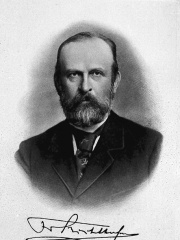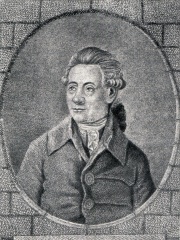

The Most Famous
GEOGRAPHERS from Poland
This page contains a list of the greatest Polish Geographers. The pantheon dataset contains 86 Geographers, 2 of which were born in Poland. This makes Poland the birth place of the 11th most number of Geographers behind Italy, and Netherlands.
Top 2
The following people are considered by Pantheon to be the most legendary Polish Geographers of all time. This list of famous Polish Geographers is sorted by HPI (Historical Popularity Index), a metric that aggregates information on a biography's online popularity.

1. Ferdinand von Richthofen (1833 - 1905)
With an HPI of 72.92, Ferdinand von Richthofen is the most famous Polish Geographer. His biography has been translated into 40 different languages on wikipedia.
Ferdinand Freiherr von Richthofen (5 May 1833 – 6 October 1905), better known in English as Baron von Richthofen, was a German traveller, geographer, and scientist. He is noted for coining the terms "Seidenstraße" and "Seidenstraßen" = "Silk Road(s)" or "Silk Route(s)" in 1877. He also standardized the practices of chorography and chorology.

2. Johann Gottlieb Georgi (1729 - 1802)
With an HPI of 59.63, Johann Gottlieb Georgi is the 2nd most famous Polish Geographer. His biography has been translated into 21 different languages.
Johann Gottlieb Georgi (31 December 1729 – 27 October 1802) was a German-Russian botanist, naturalist and geographer. A native of Pomerania, Georgi accompanied both Johan Peter Falk and Peter Simon Pallas on their respective journeys through Siberia. During 1770-1774 he travelled on its behalf to Astrakhan, the Urals, Bashkir, the Barabinsk steppe, the Kolyvanskoe silver mines (to assess the ore content), Altai, Tomsk, Irkutsk, Baikal, and Dauren. In 1783 he became an academician of the Russian Academy of Sciences in St Petersburg. Georgi was particularly interested in the Baikal region. Based on collections from far eastern Russia, in his 1775 publication Bemerkungen einer Reise im Russischen Reich im Jahre 1772, Georgi provided the first botanical descriptions of many of the region's flowering plants, among them the Baikal skullcap (Scutellaria baicalensis). Many of these plants and herbs were later collected by European botanists in China, and thereafter became rare specimens in European botanical gardens. After his fellow botanist and travelling companion Falk killed himself in 1774, Georgi edited his notes, which were published in Germany from 1785 to 1786 as Beyträge zur topographischen Kenntniss des Russischen Reichs I – III. In 1790, Georgi's description and urban plans of the city of St. Petersburg was published in German. It appeared in a second edition in Riga in 1793 and was finally translated into Russian a year later. His Geographisch-physikalische und naturhistorische Beschreibung des Russischen Reichs, a six volume edition of the geography and natural history of the Russian Empire, was published in Königsberg, Germany, from 1797 to 1802. Georgi also translated many works of Linnaeus.
People
Pantheon has 2 people classified as Polish geographers born between 1729 and 1833. Of these 2, none of them are still alive today. The most famous deceased Polish geographers include Ferdinand von Richthofen, and Johann Gottlieb Georgi.

